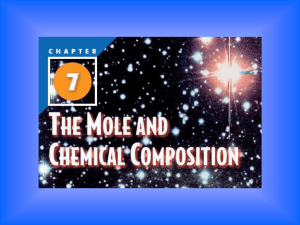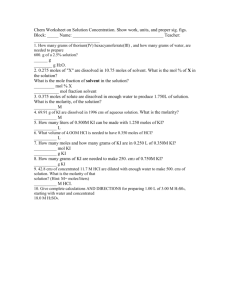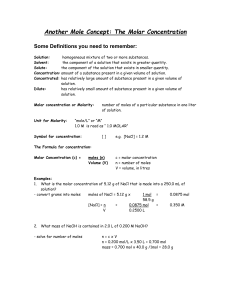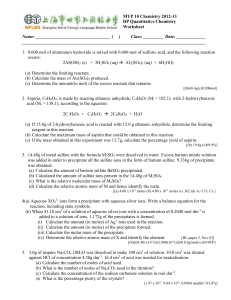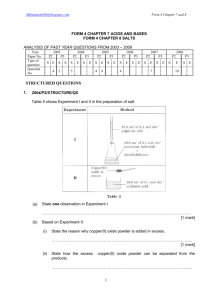Molar Concentrations
advertisement
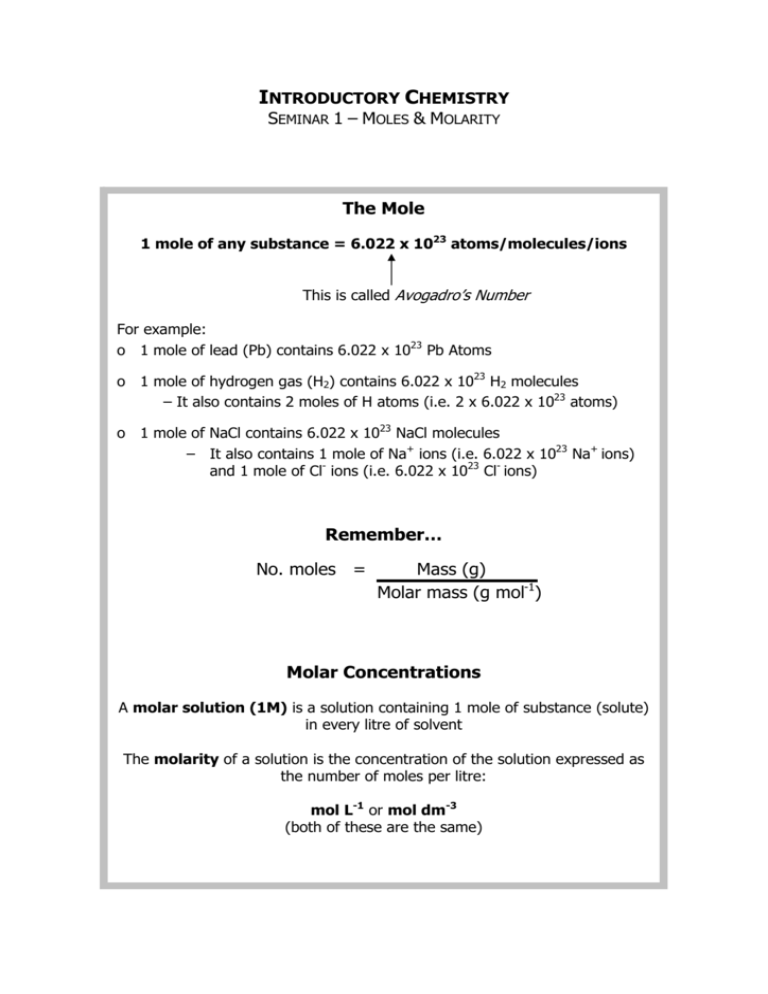
INTRODUCTORY CHEMISTRY SEMINAR 1 – MOLES & MOLARITY The Mole 1 mole of any substance = 6.022 x 1023 atoms/molecules/ions This is called Avogadro’s Number For example: o 1 mole of lead (Pb) contains 6.022 x 1023 Pb Atoms o 1 mole of hydrogen gas (H2) contains 6.022 x 1023 H2 molecules – It also contains 2 moles of H atoms (i.e. 2 x 6.022 x 1023 atoms) o 1 mole of NaCl contains 6.022 x 1023 NaCl molecules – It also contains 1 mole of Na+ ions (i.e. 6.022 x 1023 Na+ ions) and 1 mole of Cl- ions (i.e. 6.022 x 1023 Cl- ions) Remember… No. moles = Mass (g) Molar mass (g mol-1) Molar Concentrations A molar solution (1M) is a solution containing 1 mole of substance (solute) in every litre of solvent The molarity of a solution is the concentration of the solution expressed as the number of moles per litre: mol L-1 or mol dm-3 (both of these are the same) ANSWER THE FOLLOWING QUESTIONS 1. What is the molar mass of Na2CO3? 2. How many moles are in 10g NaCl? 3. What mass of Na2CO3 would you need in 1L of H2O to make a 1M solution? 4. Calculate the molarity of a solution containing 15g of Na2CO3 in 250cm3. 5. 15 g of CaCO3 was dissolved in water and made up to give a total volume of 200 cm3. Calculate the concentration of the solution in mol dm-3. 6. How many molecules are there in 106g of Na2CO3 and what is this called? 7. If 10g of Na2CO3.10H2O is used to make up a 500 cm3 solution instead of 10g anhydrous Na2CO3, calculate the difference in concentration of the two solutions obtained, in mol dm-3 and in g dm-3. 8. How many moles of molecules are present in 5.60 g of hexane (C6H14)? 9. If 3.15g of caesium chloride is dissolved in water and made up to 100 cm3 of aqueous solution, what is the concentration of the solution? 10. What mass of potassium iodide (KI) must be dissolved in water and made up to 25.00 cm3 to give a solution of concentration 0.0300 M? 11. Determine the amount present (in moles) in each of the following: (a) 5.2 g BaCl2 (b) 10 ml of 0.05M HCl (c) 3.4820 g AgNO3 (d) 1kg NH4NO3 12. What mass of solid is required to prepare 50 cm3 of each of the following solutions? (e) 0.0100 mol dm-3 MnO2 (f) 0.0500 M KMnO4 (g) 1M NaClO4 (h) 4M FeCl3 13. Typical blood serum is about 0.14 M NaCl. What volume of blood contains 1.0 mg of NaCl? 14. Calculate the number of moles of Cl- ions in 1.75 L of 1.0x10-3 M AlCl3 15. How many grams of sugar (sucrose C12H22O11) are needed to make 250 ml of a 0.01 mol dm-3 solution? 16. What volume of a 4M solution of NaOH contains 17 g of NaOH? 17. To analyse the alcohol content of a certain wine, a forensic scientist needs 1.00 dm3 of an aqueous 0.200 M potassium dichromate (K2Cr2O7) solution. How much solid K2Cr2O7 must be weighed out to make this solution? And now for some to stretch the brain… 18. A solution is prepared by dissolving 25.0 g of ammonium sulphate (NH4)2SO4 in enough water to make 100 ml of stock solution. A 10.00 ml sample of this stock solution is added to 50.00 ml of water. Calculate the concentration of ammonium ions and sulphate ions in the final solution. 19. A solution of ethanol (C2H5OH) in water is prepared by dissolving 75.0 cm3 of ethanol (density = 0.79 g/cm3) in enough water to make 250.00 cm3 of solution. What is the molarity of the ethanol in this solution? 20. A standard solution is prepared for the analysis of fluoxymesterone (C20H29FO3), an anabolic steroid. A stock solution is first prepared by dissolving 10.0 mg of fluoxymesterone in enough water to give a total volume of 500.0 ml. A 100.0 μl aliquot (portion) of this solution is diluted to a final volume of 100.0 ml. Calculate the concentration of the final solution in terms of molarity. 21. A stock solution containing Mn2+ ions is prepared by dissolving 1.584 g of pure manganese metal in nitric acid and diluting to a final volume of 1.000 L. The following solutions are prepared by dilution: (i) For solution A: 50.00 ml of stock solution is diluted 1000.0 ml (j) For solution B: 10.00 ml of A is diluted to 250.0 ml (k) For solution C: 10.00 ml of B is diluted to 500.0 ml Calculate the molar concentrations of the stock solution and solutions A, B and C.



